Fay Manners, a skier who found her passion for steep skiing after moving to Chamonix eight years ago, has embarked on an ambitious project on Aiguille du Moine. Steep skiing presented a newer challenge that she has grown to cherish. Due to unfavourable conditions for ice climbing this season, Manners decided to pivot towards a personal skiing endeavour to conquer steep slopes.
Her project outlines an audacious goal to ski three iconic steep descents in the Alps. This undertaking is not just about skiing; it involves ascending from the valley floor and cycling between these monumental slopes. Scheduled for the late season—April through June, depending on weather conditions—this initiative represents a blend of endurance, skill, and environmental adaptation.
“In the absence of ice climbing opportunities, I saw a chance to challenge myself with steep skiing objectives,” Manners explained. Her enthusiasm for the project is palpable, reflecting a deep connection to the mountains and a relentless pursuit of personal growth amidst the Alpine grandeur.
The Conception of Aiguille du Moine Ski Project
The inception of Fay Manners’ project on Aiguille du Moine began with a collaboration that would set a new standard for her skiing endeavours. Engaging with The North Face, Manners was encouraged to enhance her steep skiing skills under the mentorship of esteemed athletes Mathéo Jacquemoud, Tom Lafaille, and Guillaume Pierrel. Jacquemoud, known for his exceptional skimo expertise and endurance; Lafaille, a seasoned steep skier with a wealth of experience in Chamonix’s challenging terrains; and Pierrel, who, among other things, recently skied Cho Polu, offered Manners an unparalleled opportunity to elevate her fitness and technical prowess.
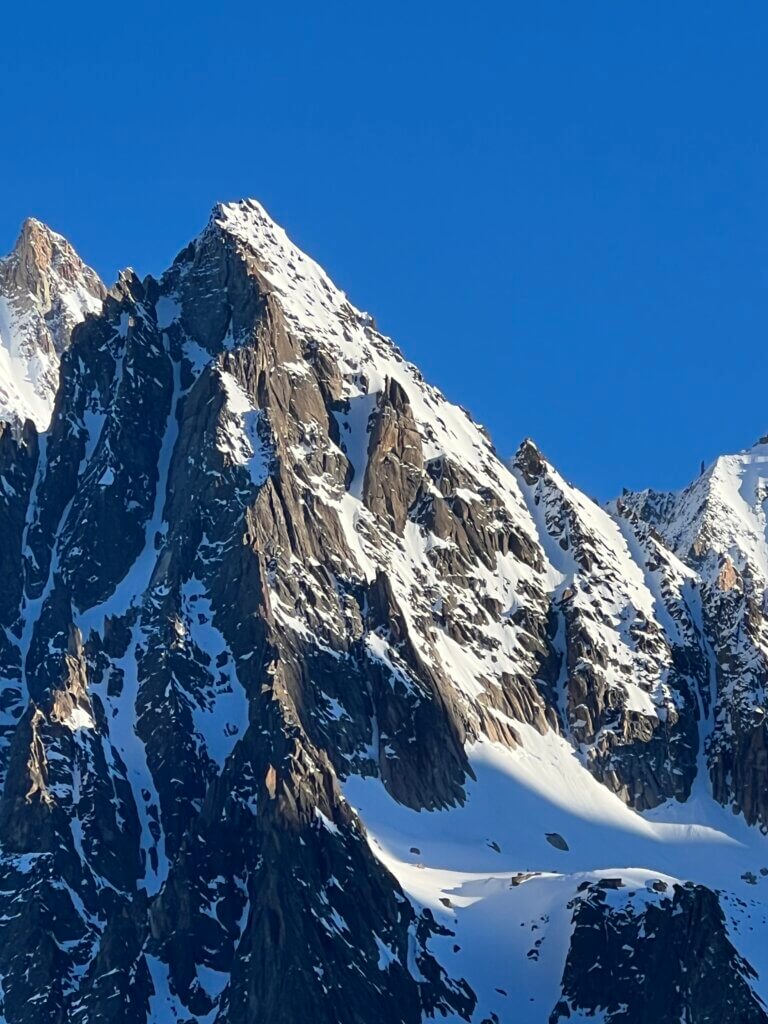
Manners’ ambition was further fueled by a captivating video of Jean-Marc Bovin’s descent on the south face, which, despite its daunting appearance, catalyzed her commitment to tackling steep, iconic faces in the Alps. “My initial reaction was a mix of awe and intimidation, but recognizing it as a prime opportunity for practice aligned perfectly with my season’s goal,” Manners recalled.
The project gained momentum when Lafaille identified a weather window presenting ideal conditions for their ascent. This period of transformational spring snow and the line’s significance to Lafaille, who had previously guided on the mountain, underscored the venture’s meaningful nature. As the duo prepared for their journey, their efforts symbolized a personal challenge and a shared ambition to conquer one of the Alps’ most revered descents.
Anticipation and Strategy: Laying the Groundwork for Aiguille du Moine
In the days leading up to their ambitious descent of Aiguille du Moine, Fay Manners and her team demonstrated the essence of preparation and foresight. Before this challenge, they had completed the first repeat of a route – “Y’a pas foule” in the Argentière bassin, originally established by Vivian Bruchez. This initial endeavour served as a warm-up and solidified their partnership, setting a confident tone for the more daunting task ahead.
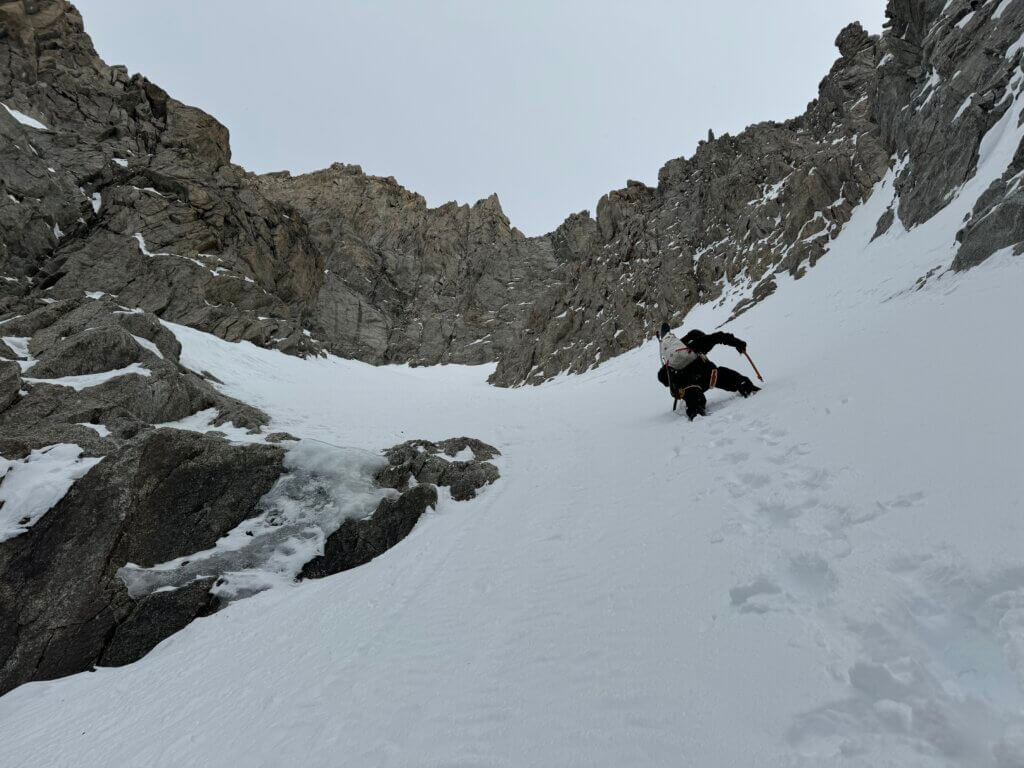
Recognizing the potential difficulties posed by the day’s warmth, which could compromise their descent’s conditions, the team opted for a proactive approach. They ascended a day early, staying overnight in a mountain hut to begin their climb in the optimal conditions of early morning firmness. This strategy allowed them ample time to scout the route, identify necessary abseil points, and ensure everything was in place for a safe descent.
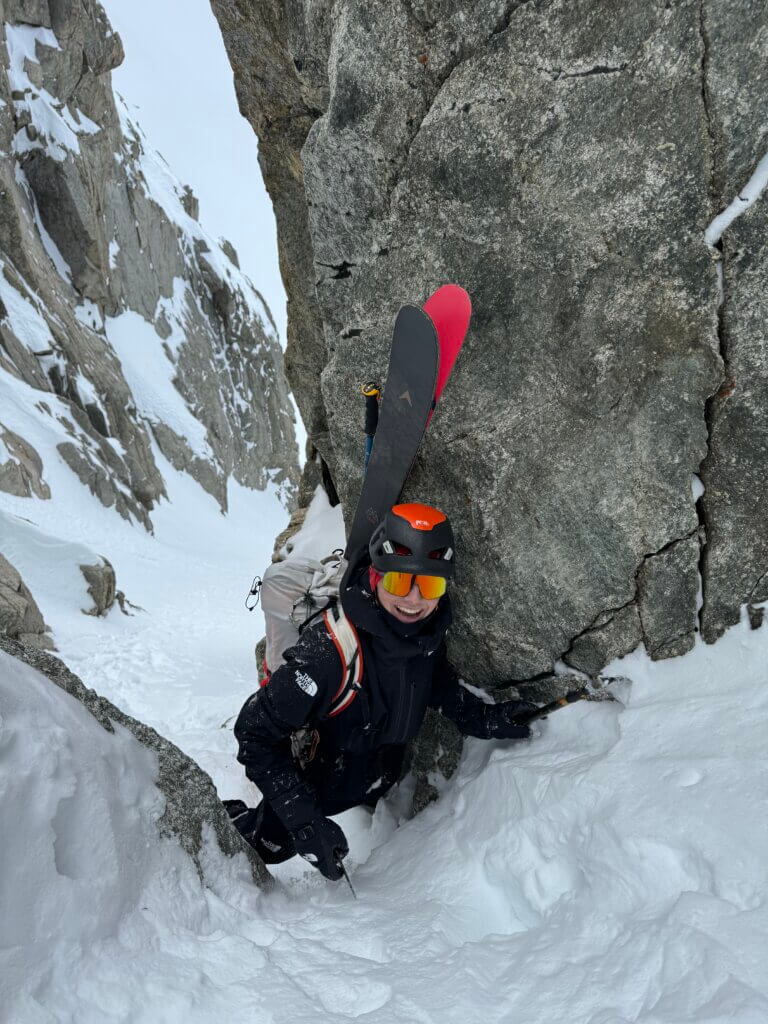
Manners highlighted the importance of this preparation phase, stating, “We thought it would be pretty difficult to manage the entire descent in good conditions starting from the first lift. So, staying in the hut and starting early was our best bet for perfect snow.” This calculated approach underscores the meticulous planning and adaptability required in high-alpine skiing, where the mountain’s unpredictable nature demands respect and careful consideration. Through their diligent preparation, Manners and her team exemplified the blend of passion and prudence that characterizes the outdoor enthusiast community.
Navigating Aiguille du Moine
Their journey began with an overnight stay at the Couvercle hut, a cosy refuge that provided a brief respite before the formidable task ahead. This prelude to their adventure set a comforting tone and hinted at the challenging journey, as even seasoned climbers in the hut drew inspiration from their bold endeavour.
Setting off at the break of dawn, around 5 AM, the team was immediately met with the stark reality of their challenge. The initial phase of their climb involved navigating a barely snow-covered rocky slab in the dark, an ordeal that foreshadowed the demanding nature of the route. The use of dual ice axes and crampons from the outset underscored the steepness and exposure they were about to confront.
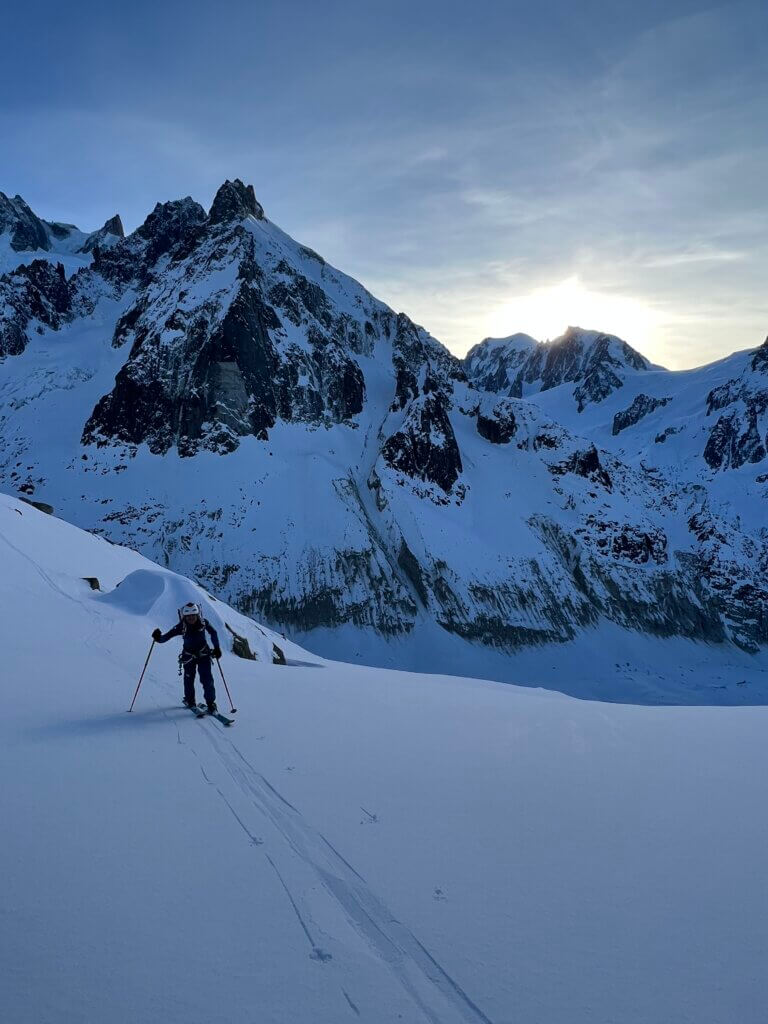
Manners described the unnerving experience of traversing icy slabs and placing protection on precarious sections. One particularly tense moment came when Tom Lafaille, leading the climb, had to devise an improvised belay from his ice axes, highlighting the adaptability required in such extreme conditions. Their ascent was punctuated by establishing two critical abseil points, a strategic move that ensured their safe descent amid the changing conditions of the mountain.
As they ascended, the daunting nature of their task became increasingly apparent. The necessity to create an Abalakov anchor for rappelling illustrated the harsh realities of high-alpine skiing, where preparation and safety are paramount. This meticulous groundwork was crucial for their success and safety in the uncertainty of predawn darkness.
Upon reaching the summit, the duo faced an unexpected challenge: a lingering cloud cover that delayed the snow’s softening, essential for a safe descent—the waiting period, filled with anticipation and anxiety, tested their patience and resolve. “I hope the snow softens up,” Manners reflected on the tense moment, capturing the blend of hope and apprehension that defines such high-stakes endeavours.
Smooth Descent: Mastering Aiguille du Moine
When the time came to descend Aiguille du Moine, the atmosphere was thick with anticipation. Tom Lafaille, a seasoned veteran of steep skiing, paused at the summit, contemplating the route down. This moment of hesitation highlighted the daunting challenge ahead. Fay Manners, observing Lafaille’s deliberation, felt awe and trepidation, realizing the magnitude of what they were about to undertake.

However, as they initiated their descent, the fear quickly dissipated, replaced by a rush of adrenaline and confidence. Manners described the transformation vividly, “After a couple of jump turns, the snow felt incredibly soft and smooth under our skis, signalling we were on the right path.” Though brief at around 400 meters, this initial part of the journey was a significant test of their skills and resolve.
The descent proved surprisingly swift, thanks to two strategically placed abseils that aided their progress. Manners noted, “The descent flew by. It was about skiing down, managing the ropes swiftly, and continuing our journey.” The meticulous preparation and the firm snow conditions that had facilitated their ascent now contributed to a smooth and exhilarating descent.
Reflecting on the experience, Manners felt a profound sense of achievement and relief, “It felt really special”.
Fay Manners’ Approach to Steep Skiing
For Fay Manners, preparing for a steep descent is an exercise in mental and physical readiness, blending her varied experiences in skiing, ice climbing, and mixed climbing. Despite dedicating three to four years to steep skiing, Manners acknowledges its unique challenge, especially when not practised exclusively. “For someone like me, who balances steep skiing with ice and mixed climbing, the mental preparation takes on greater importance,” Manners notes, highlighting the nuanced approach required for such endeavours.
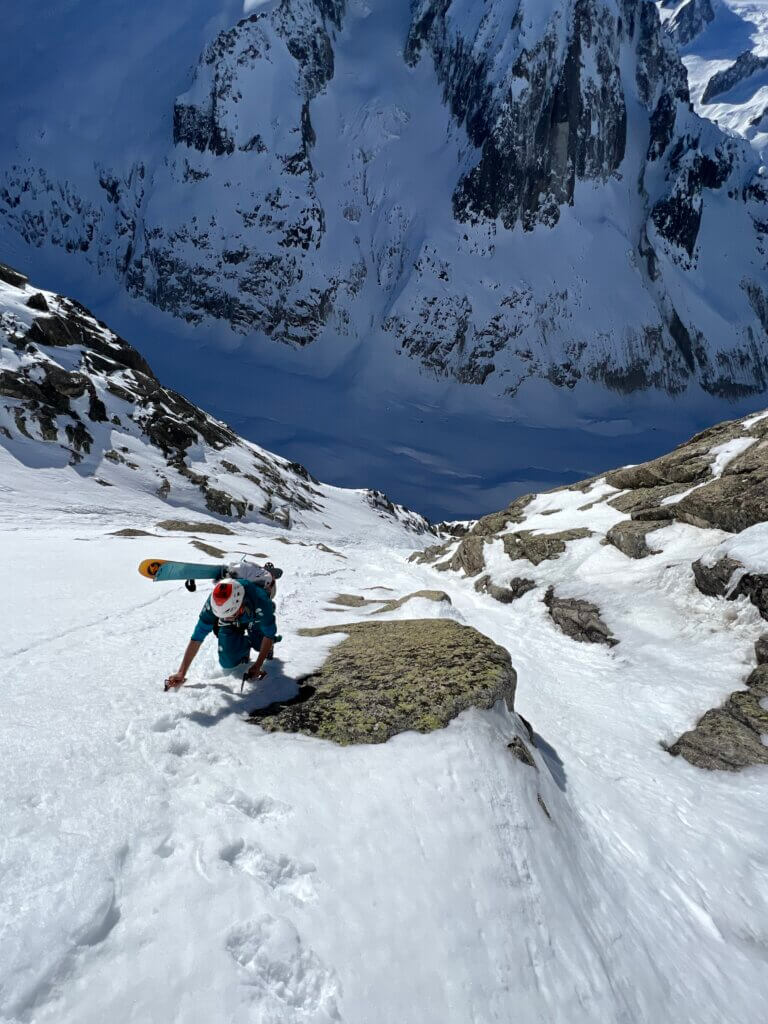
In anticipation of the descent from Aiguille du Moine, Manners and Tom Lafaille undertook a preparatory ski the day before, targeting the West Couloir on the Pierre Joseph. This strategic choice served as a primer for their conditions and challenges. “Skiing a line that’s rarely done, like the one on Pierre Joseph, helps build the confidence needed for more daunting objectives,” she explains. This methodical buildup of experience underscores the importance of familiarity with the mountain’s conditions and nuances, allowing Manners to approach her main objective with heightened confidence.
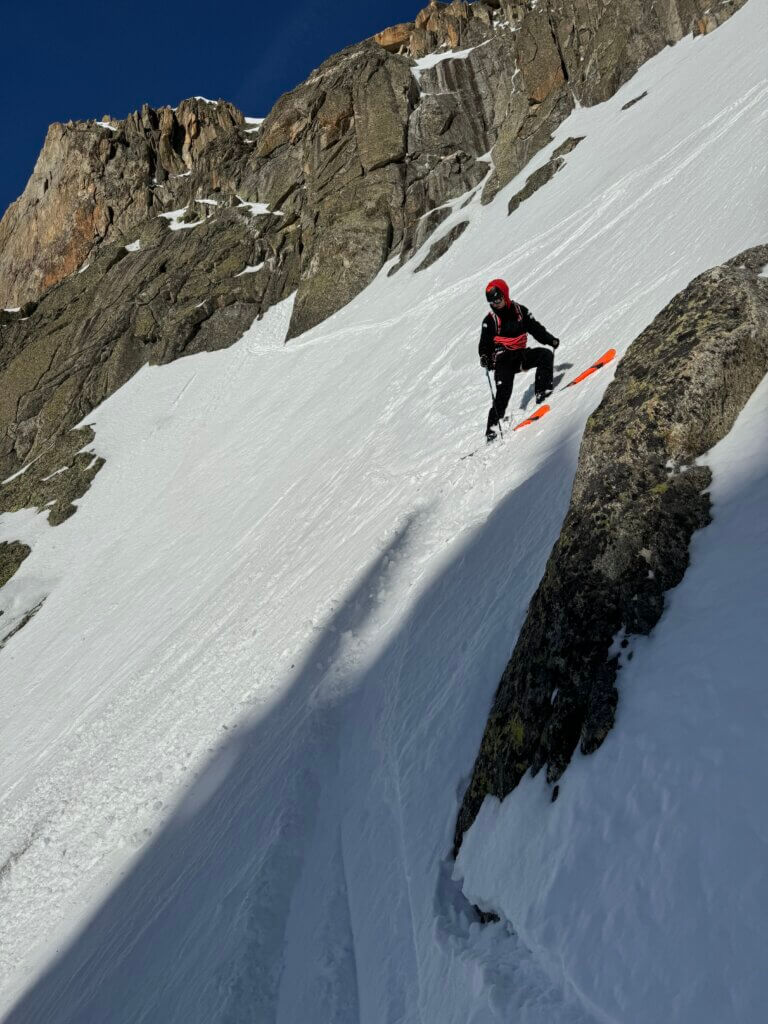
This preparatory phase is not just about physical acclimatization but also mental fortitude. For Manners, the contrast between the open, wide slopes of Pierre Joseph and the demanding terrains of Aiguille du Moine offered a valuable perspective shift, enabling her to adapt to varying degrees of steepness and exposure.
In the wake of Fay Manners and Tom Lafaille’s daring descent of Aiguille du Moine, their journey has not only marked a personal milestone but also set a new benchmark in the steep skiing community. Inspired by their feat, three other skiers (Aurélien Lardy, Jules Socié and Damien Arnaud) have since already followed in their tracks, navigating the same challenging line and contributing to the legacy of this remarkable descent. This ripple effect underscores the impact of Manners and Lafaille’s achievement, inspiring others to explore the bounds of their own capabilities.
The partnership between Manners and Lafaille, born from a chance meeting in a mountain hut while pursuing their respective adventures, has blossomed into a dynamic collaboration. Their shared passion for conquering the Alps’ most formidable descents has led to the planning of future projects, each aiming to push the envelope further in the realm of steep skiing. This evolving partnership reflects not just a mutual respect for each other’s skills but also a shared vision for exploring the uncharted territories of alpine skiing.

